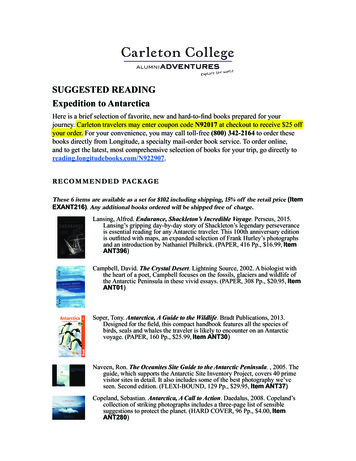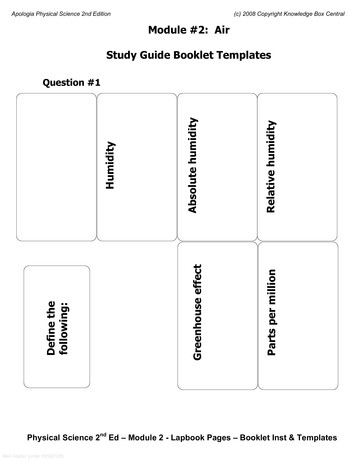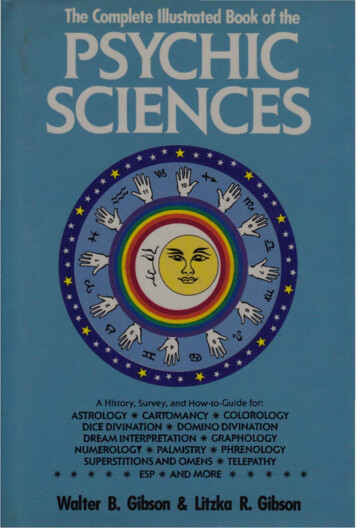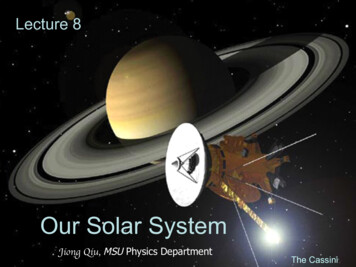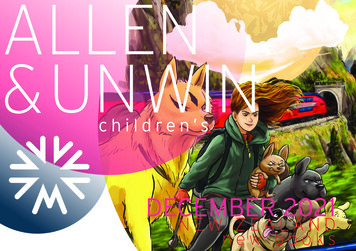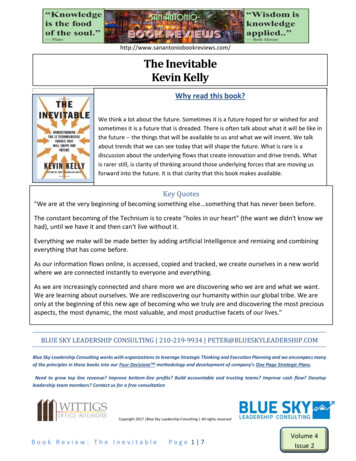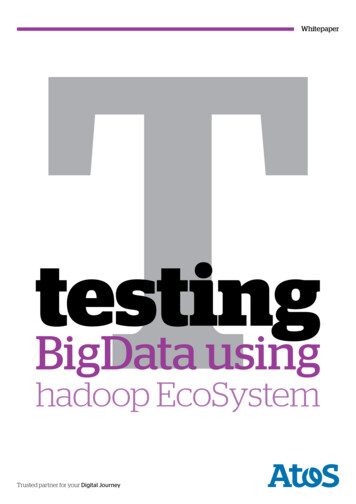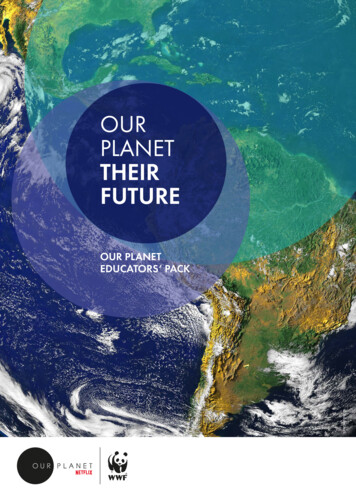
Transcription
OURPLANETTHEIRFUTUREOUR PLANETEDUCATORS’ PACK AdobeStock
“YOUNG PEOPLE ARE THE FUTURE OF OUR PLANET. WEMUST EQUIP THEM WITH THE INFORMATION, INSIGHT ANDPRACTICAL SKILLS TO UNDERSTAND THE IMPORTANCE OFBIODIVERSITY – BOTH INTRINSICALLY AND FOR THE SURVIVALOF HUMANITY. EDUCATORS HAVE A KEY ROLE TO PLAY INPREPARING YOUNG PEOPLE FOR THE CHALLENGES THAT LIEAHEAD. THERE CAN BE NO GREATER LEGACY THAN GIVINGYOUNG PEOPLE THE TOOLS THEY NEED TO SAVE OUR PLANET.”SIR DAVID ATTENBOROUGH Richard Stonehouse / WWF-UK
OUR PLANET,THEIR FUTUREToday’s young people will be the stewards of our planetin the years to come, and the future of all life depends onthem gaining the knowledge, skills and passion for naturenecessary to transform humanity’s relationship with the naturalworld and build a more sustainable future.This educators’ pack is designed to be used alongside thewealth of free videos and interactive tools onOurPlanet.com. The resources delve deeper into the biomesand issues highlighted in the Our Planet series, but it is notnecessary for students or staff to have seen the series itself tobenefit from these activities and resources.INSPIRECONNECTACT Bring the story of our planet tolife for young people with thewealth of spectacular videosavailable for free on OurPlanet.com. These videos can be usedto support lessons in geography,science, media studies, citizenship,environmental education andmore. Use the Our Planet guideto using video in the classroom tostimulate constructive discussionsand engaged critical thinking. Draw on our freedownloadable primary andsecondary classroom resourcesand educator guides to builda deeper understanding of ourliving planet, the links betweenour lifestyles and the healthof the natural world, and theactions needed to bring ourplanet back from the brink. Get involved in the OurPlanet global citizenscience project withiNaturalist.org, and joina worldwide network ofyouth-led biodiversityaction projects. Highlight how young peopleworldwide are already takingaction to create a sustainablefuture for our planet – follow theYouth Voices for Our Planet blog. Introduce the story of Our Planetto youth audiences using the OurPlanet Powerpoint presentation. Seize unique opportunities toconnect live with inspiring guestspeakers and projects aroundthe world via Skype in theClassroom, bringing the topicsand issues of Our Planet to life. Get outside and discover thenatural world around you withthe Our Planet Seek app. Speak up and add youthvoice and pledges of actionto the global movement tosave our planet. NetflixWWF’s Living Planet Report, releasedin 2018, revealed the scale of humanimpact on our precious natural world.The Netflix original documentary seriesOur Planet tells the story of the oneplace we all call home, because if weunderstand our planet, we can create afuture where we all thrive.
OUR PLANET EDUCATION& YOUTH RESOURCES Our Planet assembly packCustomisable PowerPoint and presenter guide for ateacher or student led presentation on the state of ourplanet and the path to a sustainable future (suitable forages 7-16) Classroom biome resource packs x 5Youth-orientated briefings, educator notes and worksheetsfor Forests & Jungles, Seas, Frozen Worlds, Freshwater andGrasslands (suitable for ages 7-11) Our Planet Futures Summit toolkitA toolkit for a 0.5 - 2 day workshop in which youngpeople roleplay an international summit and seek to definea sustainable future for our planet (suitable for ages 11 ) Our Planet liveSkype in the Classroom microsite with a range of exclusiveand unique opportunities for live guest speakers, virtualfield trips and international classroom collaborationsassociated with the topics of Our Planet (all ages) Seek for Our PlanetA special app for android and apple devices, createdby iNaturalist and WWF, that helps any buddingnaturalists to find and identify local wildlife. Earnin-app badges and participate in monthly globalchallenges. Citizen Science forOur PlanetA toolkit for schools,colleges, universitiesand youth groups.Use iNaturalist, thenew Seek app, orthe offline recordingtools provided tomonitor local biodiversityand initiate a biodiversity action planto improve conditions for wildlife in your community(Launching June 2019). Matt Larsen-Daw / Silverback Films / Netflix Reporting on our living planetA youth-orientated summary of WWF’s Living PlanetReport 2018, with facts and stats about the current stateof our planet and the urgent need for action to reverse thedecline of wildlife.
USING OURPLANET.COMIN THE CLASSROOM Greg Armfield / WWF NetflixIf you are working with younger age groups or sensitiveyoung people we advise viewing the videos before screeningthem in the classroom or assigning playlists for students towatch independently, in case of content or messaging thatcould cause distress.Explore Our PlanetThe explorable globe allows individual students, small groupsor whole classes to embark on a voyage of discovery intothe interconnected workings of our planet. As they followconnections around the planet, short videos pinned to theglobe bring concepts and locations to life.The Our Planet series, streaming on Netflix, illustrates howthe different biomes, species and natural systems of planetEarth connect and support each other to maintain human lifeand all the living things with which we share our home. Therich content and interactive tools on OurPlanet.com dives intomore detail about the key species, locations and processesmentioned in the series.The Our Planet website has two key sections that offerstimulating opportunities for teacher-led or student-led learning.Videos are grouped into sections to match the focus of eachepisode of Our Planet. The first section, Our Story, looks atthe big picture, with a selection of unique perspectives andinsights into the state of our planet and how we got to wherewe are today.Teacher-ledThe explorable globe makes a perfect visual aid forinteractive whiteboards, especially for geography lessons.It allows you to illustrate the locations of focus species andbiomes, and the scale of impact of human behaviour on ourplanet over time. Switch information layers on and off to suitthe focus topic. NetflixDiscoverBrowse a searchable library of high quality videos perfectfor classroom inspiration and student-led research into theplaces, species, and issues featured in Our Planet.Student-ledStudents may be assigned research tasks in the form of atopic presentation task or a quiz sheet, and through seekingthe information required they will gain a valuable insight intothe connections between topics and issues.
OUR PLANET VIDEODISCUSSION GUIDE FOR EDUCATORSOurPlanet.com provides a wealth of high quality video content that can introducenew ideas and stimulate discussion amongst students of all ages. The following tipswill help you make the most of this free bank of videos and the insight they bring tothe current state of our planet and the decisions we must make for the future.2. Capture ideas and perspectives while they are freshIt is useful to give some context for the video before playingit, so that students have a sense of why they are watching itand how to frame their thoughts about what they see. It mightnot be that you tell them anything about the content, but youcould ask them to hold certain questions in mind when theyare watching. These could include:Give your students sticky notes to write their thoughts down asthey watch the video. You could give them different colourednotes for ‘happy’, ‘sad’ or ‘surprising’ thoughts, or restrictthem to noting down single words that convey the feelingsand themes they feel are brought up by the video.a) How does this video make you feel?b) What is the message of this video?c) Where was this video filmed and what can we tell aboutthat place?d) How do you think the film-makers created the video? Whatchallenges might they have faced?After the video has finished you can use these as a startingpoint for discussions in pairs, small groups or the whole class.Alternatively, you can ask everyone to stick them up on thewall and see what common themes emerge. Ben Mcdonald / Silverback Films / Netflix1. Provide a framework
3. Give time for reflectionWatching a video is a private experience, and each studentmay pick up on different aspects of the video as interesting,moving or surprising. It can be very valuable for students tohear a range of different perspectives on a video and canhelp them to understand that people see things differentlyand that there is more than one valid viewpoint. There maybe scientific facts in the video, but every viewer may feela different response to these facts, and may have differentopinions about the way the video communicates those facts.Give the students some quiet time after viewing a video tocompose their thoughts and make notes. This allows them togain confidence in their perspective before they hear anotherfrom a teacher or fellow student, which might otherwiseinfluence them.4. Encourage diverse perspectives5. Let the students leadOne of the best ways to avoid influencing your students’reactions and missing out on interesting and unexpectedobservations is to stay out of the discussion altogether.Introduce a structure for student-led discussion of videos anduse it whenever you show content in class. Over time thestudents will increase in confidence and these discussions willbecome more and more fluid.This set of rules provides a good starting point for student-leddiscussions.1. Every student contributes – however briefly2. Respect every contribution by listening attentively andquietly3. Every contribution should respond constructively toprevious contributions by including at least one of thesethree elements:a) Agree with a point made in a previous contribution andexplain why you think the sameb) Build on a point made in a previous contribution toexplore an idea furtherc) Challenge a point made in a previous contribution byexplaining why you see it differently4. When finished, select the next student to contribute untileveryone has spoken.This format encourages active listening and avoids studentsstraining to get attention so that they can make a point, whichis distracting for them and other students.6. Build suspenseStudents will be especially attentiveif they are curious about what they are about to watch, or ifthey have built up expectations that they are eager to test.One way to create this sense of suspense is to give somedetails about the video or its subject and ask the class to discusstheir ideas for what they might be about to see. For example,you could say that the video is to do with their project onAfrican grasslands, but is filmed in a restaurant in New York.Their theories – or lack of them - about what the connectioncould be will increase their anticipation of the film itself andadd an extra dimension to the discussion afterwards.Alternatively, you could start to play a video and then pauseit halfway through for a discussion about what they think willhappen next and what they think will be the key message ofthe video.7. Embrace the magic of the movies!A huge amount of work goes into creating high quality films –especially natural history documentaries capturing elusive andunpredictable wildlife in environments that are dangerous ordifficult for humans. Our Planet offers spectacles and insightsfrom the natural world that have never been captured in suchhigh quality before, and there is every reason for you andstudents to get excited about watching them. The tips abovecan ensure that the videos provide a jumping off point for a richeducational journey, but should not detract from the joy andwonder felt by students in watching the videos in class.Dim the lights, maybe even crack out some popcorn, and letthe videos take you and the class on a journey. You mightwish to view videos twice on either side of a discussion, sothat students can relax into the experience without worryingabout missing details they need for a class analysis.Alternatively you could end a lesson with a viewing of thenext video up for discussion in a future lesson – or onechosen by the students from a selection that will not be subjectto analysis. Gisle Sverdrup / Silverback Films / NetflixWhen students start voicing their thoughts about a video,ensure that your prompts and reactions don’t lead yourstudents towards one particular reading. You can praisean interesting or eloquently expressed response withoutsuggesting that it is the ‘correct’ response. When you haveheard one student’s thoughts you can invite diversity byasking specifically if any other student has a perspective thatis completely different or even opposed.
Grace Frank / Silverback Films / NetflixOUR STORYOUR BALANCED PLANET Ben Mcdonald / Silverback Films / NetflixOur planet is made up of huge areas called biomes.These are places where animal species have adaptedto the climate and plants in their environment. Thespectacularly beautiful frozen poles of the Arctic andAntarctica are one biome that most people nevervisit. Grasslands, which may be called the prairiesin the United States or savanna in Africa, arevast spaces roamed by grazing animals. Thetemperature, amount of water or light, and soilsshape what life exists in a biome. Biomes cancontain many different ecosystems. Sophie Lanfear / Silverback Films / NetflixOur planet has evolved over billions of yearsto form the carefully balanced system thatnow gives us all that we need to stayalive. We could think of it as a hugetree of life, with millions of leaves. Allthe leaves are connected, keeping thetree alive. If one branch, or too manyleaves, on the tree is damaged then theconsequences for the whole tree can bedevastating. In the same way, all life onEarth is connected.
EVERYTHING IS CONNECTEDA NEW EPOCHOur planet is so vast that it can be easy to forget howdelicately it is balanced. Each biome is closely connectedto the others and a change in one will affect the others. Likethrowing a stone into a pond, the ripple effect of any changestouches every part of our planet.Today our planet is facing its biggest challenges ever – andthat’s because of us. Human activity is changing every partof our planet. These changes are so great that scientists aresaying that we have entered a new age – the Anthropoceneepoch, meaning ‘the age of humans’.Forests are more than just a collection of trees. They are aset of ecosystems which are home to the greatest variety ofspecies on earth. If we cut them down, we don’t just lose theclean air that we breathe. We set off a series of knock-oneffects that can be felt across the planet. If less carbon isabsorbed by forests global warming increases. This in turn willlead to the melting of the ice caps and rising sea levels whichcould see cities such as Mumbai and New York floodedwithin the next 100 years.Humans have only been around for 200,000 years, a tinysliver of time in comparison to the 4.6 billion years of ourplanet’s history. Yet in that time we have had a greater impacton our planet than any other species – and our impact isincreasing. We have spread into almost every part of theplanet, cutting down forests to create farm land and, overtime, settling into huge cities. Technological changes haveled to the growth of industries and we now consumemore of the earth’s resources than ever before.SPECIAL QUALITIESOur planet has special qualities that help it stay healthy. Wecan think of these as the building blocks for our planet’s lifesupport system. Each one can be linked to a different biome.Space (grasslands)Huge expanses of land where animalscan migrate over hundreds of miles in theirsearch for food and water.Diversity (jungles)A rich variety of life which sees thousands ofspecies interact in a complex web.Flow (freshwater)A constant flow of fresh water that keeps allliving things alive.Ice (frozen worlds)An ‘air-conditioning system’ that keeps ourplanet cool while supporting diverse life inthe harsh polar regions.Abundance (coastal seas)Oceans teeming with life, where thrivingpopulations of smaller creatures ensure foodfor larger predators and humans.Hotspots (High seas)Places in the ocean where nutrients rise fromthe bottom and cause concentrations ofdiverse life.FACING THE FUTUREClimate change means that today one in six species on ourplanet is at risk of extinction and the total number of mammalshas decreased by a quarter since 1970. Our planet’s wildlifeis being pushed into an ever-smaller area, with just a quarterof ice-free land considered wild today, compared to halfthree centuries ago.In this new epoch, we face stark choices. If we continue totake more from our planet than we put back then we risk itsvery survival. But this could also be an epoch of opportunity.We understand what is happening and how we can changethe way we live to shape a better future for our planet,where human beings can thrive alongside nature. By makingthe right choices now we can nurture our planet’s specialqualities and protect the Earth for many generations to come.ACTIVITIESThese activities for classes or youth groups areintended to allow young people to develop theircritical thinking skills and participate actively in theirlearning. Through discussion and debate they willexplore their own values and attitudes, and by lookingat issues that are important to them and their future it ishoped that they will develop a commitment to playinga part in shaping a brighter future for our planet. AdobeStockResilience (forests)The ability to bounce back and grow againafter extreme events such as fires or drought.OUR ACTIONS HAVE LEDTO CLIMATE CHANGE, ASWE CONTINUE TO BURNVAST AMOUNTS OFFOSSIL FUELS, PUMPINGCARBON DIOXIDEINTO THE EARTH’SATMOSPHERE.
WE ARE ALL INTHE SAME BOATAGES 8 – 14ACTIVITY120 MINUTESThis introductory activity may be usedacross the age range 8 – 14 years. Youngpeople use a cartoon as stimulus materialto develop a deeper understanding of theconcept of interdependence. Cartoons can be auseful way of engaging young people’s interest in anissue as they decode the immediate and then explore the‘bigger picture’ of the message that it conveys.LEARNING OUTCOMESWHAT TO DO Young people will build their understanding of theconcept of interdependenceShow young people the cartoon and ask them, in groups offour, to look closely at the image. What is happening in thepicture? What is the main message that the cartoon is trying toconvey? Do they think that the cartoon conveys this messagewell? What might be a good caption for the cartoon? Young people will consider the effective use of cartoons Young people will develop their group work skillsRESOURCES NEEDED A copy of the cartoon. Show this on the interactivewhiteboard or photocopy one for each group of 4young people. A large sheet of paper and pens for each group of 4young people.Now use the cartoon to draw out the concept ofinterdependence. Ask them to write the word in the middleof a large sheet of paper and around it note down asmany thoughts as they can. Young people should notedown everything at this point, without discussion. After ashort time, bring the whole class together and ask eachgroup to share their ideas before coming to a shared classunderstanding of the term.Link this back to the cartoon and consider the idea thateverything on our planet is connected. Can young peoplethink of some examples of this? For example, if we all ate lessmeat then it is likely that less grassland and forest would becleared to make way for agricultural production.Finally explain to young people that they will be deepeningtheir understanding of interdependence in the next lesson.
What areyou doing?! STOP!!!trsiveDiyWhy should I?I’m only drilling undermy own seat!encilieResCommunity
BIOMEBULLETINSAGES 8 – 11ACTIVITY2TWO SESSIONS50 MINUTESThis part of the lesson, which spreads overtwo sessions, is aimed at young people aged 8 –11, and further develops their understanding of theconcept of interdependence. After considering thespecial qualities of our planet’s biomes young peoplego on to create news reports from each one.LEARNING OUTCOMESRESOURCES NEEDED Young people will understand the importance of differentbiomes and their qualities for the future of our planet. Four of the Special Qualities sheet, cut up, so that eachpupil (in a class of 28) has one statement. Note that youmay need to duplicate some statements if you have morethan 28 young people. Young people will use their knowledge and understandingto write a short news script Young people will develop their presentation skills Young people will develop their group work skills A set of the Biome Pictures, pinned up around theclassroom. A copy of a different Biome Briefing sheet for each groupof 4 young people. A brief news report on an environmental issue to show tothe class. One copy of the News Report task sheet for each group of4 young people.
WHAT TO DOSESSION 1If Part 1 was carried out during a different sessionyou will need a quick recap on the concept ofinterdependence. We, together with every living thing,depend on our one planet, Earth. If we look after andprotect it then it will go on providing all that we needlong into the future. It’s up to us!Give each pupil a slip of paper with a Special Quality onit. Ask them to move around the classroom telling otherswhat their Special Quality is and exploring it together.After a short time ask young people to find others with thesame Special Quality. In their groups they should thinktogether about which biome their Special Quality might belinked to. Once everyone has decided, each group shouldmove to stand in front of the relevant Biome picture.2. Why is this biome important? What special qualitiesdoes it have?3. What threats are there to the biome?4. How can the biome be protected?Finally explain to young people that they will beworking together to produce a short report with an itemof news from their biome. Can they think of an issuethat would be particularly relevant to their biome? Forexample, overfishing means that nine outof ten valuable large fish havebeen removed from theworld’s oceans.Now ask each group to take the Biome Picture to theirtable and give each one the relevant Biome Briefingsheet. Ask young people, as a team, to read the sheetand consider the following questions:1. What are the characteristics of this biome? Think of theclimate, habitats, species that live there etc.SESSION 2Begin the session by recapping on some of thechallenges to their Special Qualities that biomes face.Explain to young people that they are going to producea short news report on some of these issues. Showa recent news report on an environmental issue andconsider together what the key parts of a good newsreport are. These might include an introduction wherethe reporter explains the story, interviews that presentdifferent viewpoints, a summary of the main points and alead in to the next news item.agree on eachperson’s role(news presenter,interviewer,interviewees, camera personetc). Once young people havehad the opportunity to write their scripts,give them time to rehearse and film them. You may wish thisto take place over several lessons, but doing this activityrelatively quickly and spontaneously also works well.In their groups ask young people to write a short newsscript using the News Report task sheet. They shouldOnce the films have been made, allow each group timeto show their news report to the rest of the class.EVALUATION/REFLECTIONEXTENSION WORKYoung people should think about what worked well ineach news report and what could be improved. Did themessages come across clearly? Refer back to the cartoonand ask young people what they have learned aboutinterdependence. Can they think of some action that they cantake to protect the Special Qualities of our planet’s biomes?Edit the ideas into a film that could be shown in a schoolassembly.
NEWS REPORTWORKSHEETEvery biome on our planet provides us with something specialthat we need to survive. You are going to prepare a scriptfor a news report from your biome. You’ll be reporting onan event that’s taking place and will need to make sure thateveryone who watches your report will be encouraged to dosomething to protect our precious planet.Here are some handy tips to remember as youwrite your news report script. What makes this story important? Why will it be interesting for youraudience? Telling the story to a friend will helpyou get your main ideas clear.GET THEINFORMATIONACROSSHOOKPEOPLEIN How are you going to presentthe story in a way that makespeople want to watch? Who will you interview?Having two interviewees withdifferent viewpoints helps. Keep your script short and snappy Write as you speak and try to keepyour script informal. Use short, clear sentences. Make sure that yourmessage is clear – tellpeople what they can do. What is happening? Why is it happening? Who or what is affected? How has this happened? Guide your audience through your storyEXTENSION ACTIVITYPrepare and film the news report, includingimages or footage sourced online. Don’t let the interviewsgo on for too long – a fewsentences are all you need.ANDREMEMBER. Say who the interviewees areand where they come from. Remember to thank interviewees. Summarise your reportat the end and rememberto sign off and introducethe next item. Matt Larsen-Daw / WWFGET AGOODSTORY
BUILDINGBIOMESAGES 11 – 14ACTIVITY31 HOURThis activity allows young people toexchange information in an interactiveway and then use it to explore whatsteps can be taken to protect theSpecial Qualities of the differentbiomes on our planet.LEARNING OUTCOMES Young people will become familiar with the concept ofinterdependence Young people will reinforce their own learning by sharinginformation with others Young people will reflect on what steps they can take tobring about change Young people will develop their groupwork skillsPREPARATION AND CLASSROOM ORGANISATIONYou will need a fairly large space so that young people canmove around easily.RESOURCES NEEDED A copy of the Biome Factsheet. You will need to cut this upso that each pupil can be given a slip of paper. There are28 slips in total so you will need to duplicate several if youhave larger numbers of young people. The biome images from the Our Planet assembly pack,printed and stuck up around the room.WHAT TO DORecap on the introductory activity and the concept ofinterdependence. Then give a slip of paper with a statementfrom the Biome Factsheet to each pupil explaining that theyare going to be sharing this information with others. Ask themto read their statement to make sure that they understand it.Now ask young people to move around the room sharing theirstatement with as many people as possible. They should addin their own knowledge and explain their statement by givingexamples if they can. Young people should also discuss linksbetween their own statements and those of others.After young people have had the chance to share theirinformation, if they have not naturally already done so, askthem to form groups with those whose statements link to theirown. Draw attention to the Biome Pictures around the roomand ask each group to move to the picture of the biome thatthey feel is most relevant to their group.EVALUATION/REFLECTIONIn their groups, ask young people to think about how theSpecial Quality of their biome contributes to keeping ourplanet healthy. Our planet is made up of a system of interconnected, wild habitats. None can work alone and tothrive we all need to work in harmony with nature. It wouldbe helpful to refer back to the cartoon and the concept ofinterdependence.Finally, ask young people to discuss with a partner whatpractical steps can be taken by themselves or the wider schoolcommunity that will help preserve the special qualities of theirbiome. For example, encouraging people to eat fish that hasan MSC label will help ensure that oceans are protected.
BIOME FACTSHEETSPECIAL QUALITYSPECIAL FEATUREOur planet has space. Grasslands oncecovered a quarter of the Earth. Their fertilesoils make them perfect for farming. This spacehas been used by people for 10,000 years togrow crops and support herds of livestock.Grasslands support huge numbers of grazinganimals such as zebra, antelope and wildebeestwhich need space to roam and feed.THREATSWHAT CAN WE DO?As more and more land is used to grow cropsand feed livestock, animals are forced tocompete with people for space.We can stop our planet’s space being givenover to huge plantations that grow just one crop.By 2000 over 45 per cent of temperategrasslands had been converted for use bypeople.With farming methods improving all the time wecan grow all we need using less space.SPECIAL QUALITYSPECIAL FEATUREForests cover one-third of our planet’s land.They have the resilience to survive harshconditions and spring back to life aftersevere setbacks.About 30 per cent of our planet’s landis covered by forests which can surviveextreme conditions such as fires, droughtor cold.Some forest trees produce seeds whichhave a tough outer coat and need fire togerminate.THREATSWHAT CAN WE DO?Around 1.6 billion people depend on forestsfor their living.People have used forests for thousands of yearsbut they lose their resilience if too much is takenfrom them.Yet forests are being cleared to make wayfor agriculture – an area of forest the size of27 football fields is cut down every minute.We need to manage forests sustainably so thattheir natural resilience can help them survive.
BIOME FACTSHEETSPECIAL QUALITYSPECIAL FEATUREBiodiversity is the huge variety of animalsand plants, and the places that they live,which give us all we need to survive.Jungles are home to more species than any otherland habitat, with many still undiscovered.The Amazon rainforest is thought to behome to 10 per cent of all known specieson Earth.The biodiversity of jungles has given usmedicine
available for free on OurPlanet. com. These videos can be used to support lessons in geography, science, media studies, citizenship, environmental education and more. Use the Our Planet guide to using video in the classroom to stimulate constructive discussions and engaged critical thinking


